![]()
![]()
![]()
Use LEFT and RIGHT arrow keys to navigate between flashcards;
Use UP and DOWN arrow keys to flip the card;
H to show hint;
A reads text to speech;
24 Cards in this Set
- Front
- Back
|
Stromal Cell
|
-Needed for B cell development in the bone marrow
-Non-lymphoid -Interact with developing B-cells via surface adhesion molecules and secreting growth factors -Stem cell factor (SCF) on stromal cells interacts with Kit on developing B cells (promotes proliferation) -IL-7: Produced by stromal cells; stimulates growth and proliferation of late pro-B and pre-B cells |
|
|
Large pre-B cell
|
Mu heavy chain is made
|
|
|
Immature B cell
|
both the heavy and light chain have been made. IgM will be on the surface of the cell
|
|
|
Pre-B-Cell receptor
|
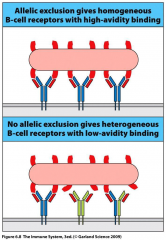
Causes allelic exlusion at heavy chain locus
-results in homogenous B-Cell receptors with high-avidity binding -This is when only one Gene is expressed (and the other is silenced) |
|
|
B Cell development checkpoints
|

1. Selection of functional heavy chains
2. Selection of functional heavy chains |
|
|
Gene rearrangements leading to surface Ig
|
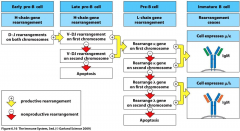
|
|
|
Self binding B cells
|

Different light chains can be tried if they have not all be used already (all the kappa and lambda)
|
|
|
Anergic
|
Antibody that will not react to foreign antibody
|
|
|
Site of B-cell maturation
|
B cells differentiate in the primary follicle and form the the secondary (germinal centers).
This process is aided by the interactions of T cells **ISOTYPE SWITCHING (REMOVAL OF C) AND SOMATIC HYPERMUTIAOTN OCCUR IN IN THE GERMINAL CENTERS |
|
|
B cell tumor (overview)
|
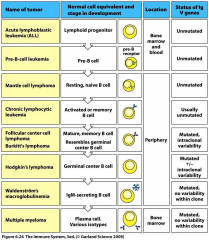
|
|
|
Burkitt's Lymphoma
|
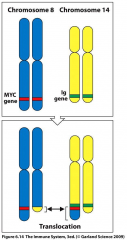
Translocation at the chromosomal level leads to the fusion of genes
|
|
|
B1 vs. B2 cells
|
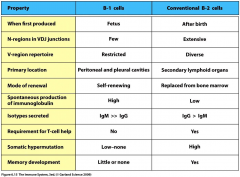
|
|
|
Summary of B cell development
|
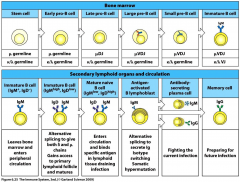
|
|
|
αß T cells
|
Recognize peptides bound to self MHC molecules
-CD4 (MHC class II) and CD8 (MHC class I) |
|
|
γδ T cells
|
Some will react to self MHC, some however will react to to free antigen
|
|
|
T cell development
|
Develop in the thymus
αß T cells: 1. Positive selection (to ensure self MHC recognition) 2. Negative selection γδ T cells: leave the thymus once their T cell receptor (TCR) has productively rearranged |
|
|
Development of most T cells
|
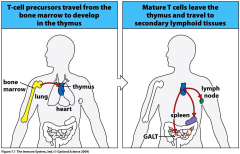
Most T cells develop in the thymus
|
|
|
DiGeorge's Syndrome
|
Thymus fails to develop and no T cells
-patients are susceptible to wide range of opportunistic infections -One type of SCIDS |
|
|
αß and γδ development
|
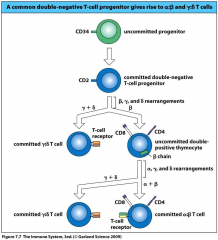
|
|
|
Synthesis of T-Cell receptor ß chain
|
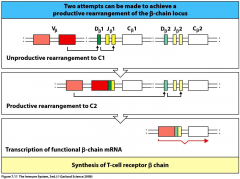
|
|
|
Bare lymphocytes syndrome
|
results when either the MHC class I or MHC class II is not expressed.
- causes SCIDS |
|
|
Autoimmune regulator (AIRE)
|
Transcription factor is responsible for the tissue specific proteins in the thymus
-Lack of AIRE results in autoimmune disease called: AUTIMMUNE POLYGLANDULAR SYNDOME TYPE I -or- AUTOMIMMUNE POLYENDOCRINOPATHY-CANDIDIASIS-ECTODERMAL DYSTROPHY |
|
|
CD4+ Regulatory T cell (Treg)
|
suppress proliferation of naive self-reactive cells
-Humans lacking Treg suffer from: immune dysregulation, polyendocrinopathy, enteropath, X-linked syndrome -This prevents the body from forming antibodies against self |
|
|
FoxP3
|
Transcription Factor
Lack of it results in absence of Treg cells and IPEX disease. This results in autoimmune response against multiple organs (includig gut, skin, and pancrease) |

